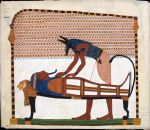Tomb Painting conservation
 The facsimile tomb paintings made by the Rev Colin Campbell at the turn of the twentieth century have recently been 'rediscovered' in The Hunterian thanks to collaboration between Angela McDonald (currently teaching Egyptology at the Centre for Open Studies at the University of Glasgow) and Dr Sally-Anne Coupar (ex Curator of Archaeology at The Hunterian). Efforts to make the museum’s collections more accessible resulted in the paintings being used for teaching sessions and student projects in 2009. As a result several things were clear; the paintings represented a wonderful opportunity for creative teaching use and are extremely popular with a variety of audiences, the “back story” of the Rev Campbell was fascinating in itself and conservation was an urgent priority.
The facsimile tomb paintings made by the Rev Colin Campbell at the turn of the twentieth century have recently been 'rediscovered' in The Hunterian thanks to collaboration between Angela McDonald (currently teaching Egyptology at the Centre for Open Studies at the University of Glasgow) and Dr Sally-Anne Coupar (ex Curator of Archaeology at The Hunterian). Efforts to make the museum’s collections more accessible resulted in the paintings being used for teaching sessions and student projects in 2009. As a result several things were clear; the paintings represented a wonderful opportunity for creative teaching use and are extremely popular with a variety of audiences, the “back story” of the Rev Campbell was fascinating in itself and conservation was an urgent priority.
Funding for conservation was sought and awarded by Museums Galleries Scotland between the period July 2009 and December 2010. There were three phases of conservation, partly dictated by the funding restrictions and partly by design to make the project manageable for the conservator. Of the thirteen paintings, four are very large; the largest measuring 20 feet long by 5’8’’ wide [6.1m x 1.77m] and the others decreasing in size to the smallest which is a not inconsiderable 3’7’’ x 4’5” [1.1m x 1.3m]. They are made of paper which has been glued on to a cotton fabric background. In the case of the very large paintings, the paper panels have been applied in a patchwork pattern to provide the necessary surface area.
Archival photographs show that the museum had a policy of displaying as many things as space allowed, so in 1925, when the paintings arrived in the Hunterian, it is very likely that they immediately went on display. One of the main causes of damage to paintings is light which causes the colours to fade and the paper to become dry and very brittle. Although they were probably on display for quite a long time, the colours of the paintings are still vibrant. As part of the conservation process, the paintings were relaxed with humidity then tension dried to remove creasing and wrinkles. Repairs were carried out to the tears and weaknesses in the paper using Japanese paper and wheat starch paste to heal old holes made by the paintings being pinned up.
Hanging tabs of linen were then attached at intervals of about 40cm to the back of the top edge of each of the works using adhesive. The tabs are attached to enable the works to be displayed: they can either be pinned through, or held by people so that the paintings can be used for teaching without being touched. Rods can also be inserted through the loops to hang the works up. This eliminates excessive handling but is flexible enough to allow the paintings to be portable, as they are now stored rolled up, and therefore can be used for teaching in various locations. Now that they are conserved other uses, such as displays, are possible and increased use for teaching and research is anticipated.
Following the successful conservation of the paintings a grant from Egyptology Scotland in early 2011 allowed them to be photographed at a high resolution. Dr Angela McDonald writes “The conservation of the paintings will allow them to be used directly, rather than in facsimile form. For those who are able to study them, it will be the next best thing to following the Reverend’s footsteps to Thebes! It is tremendously valuable to be able to show students and members of the public complete scenes rather than just the kind of excerpts publications include”.

